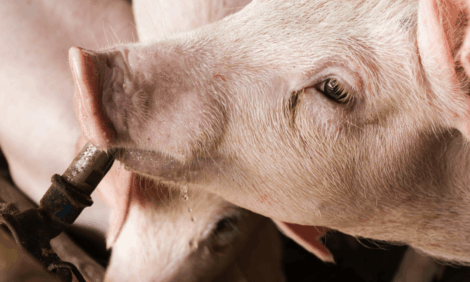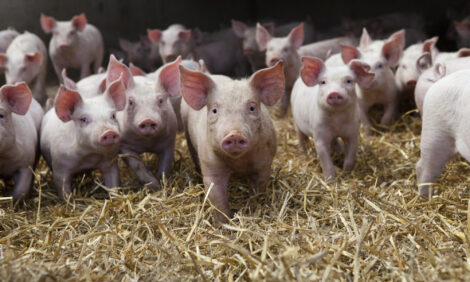



Scientific Opinion on African Swine Fever
Awareness of both pig farmers and veterinarians of the risk of African Swine Fever (ASF), especially in limited and free-range production sectors should be increased. This is one of the recommendations made by the European Food Safety Authority in its Scientific Opinion on African Swine Fever.Following a request from The European Commission, the Panel on Animal Health and Welfare was asked to deliver a scientific opinion on African Swine Fever and to assess:
- the significance of the occurrence and risk of endemicity of ASF in the countries neighbouring the EU
- the possibility of ASF becoming endemic in domestic pigs and to maintaining itself in a wild boar population in the EU, keeping in mind the differences in virulence of ASF virus strains, in particular the virus strains which are now endemic in the Caucasus region;
- the role played by vectors in the spread and the maintenance of ASF and provide geographical information and maps of Member States displaying the geographical distribution of Ornithodoros erraticus as well as other potential invertebrate hosts.
Methodology
Due to limited data available, a systematic qualitative risk assessment framework based on the World Organisation for Animal Health (OIE) guidelines was developed to address the identified risk questions to satisfy the above mandate. The model considered factors affecting spread of the disease and assessed the impact of preventive and control measures. Opinions from the working group members were used to outline the various pathways of the disease occurrence and/or its spread and to assess the likelihood of events occurring. This information was collectively used to obtain overall risk estimates. From the start, exchange of knowledge between the ASFRISK experts (Community's research project: KBBE- 2007-1-3-05, Grant Agreement nº 211691) and the Working Groups existed.
Background Information
The ASFV circulating in the Trans Caucasian Countries (TCC) and the Russian Federation (RF) is a highly virulent virus that has maintained its virulence since the first outbreak in Georgia in 2007. The potential evolution of this virus, however, should be considered since previous experience in other regions, with other strains, indicated a decrease of virulence after a certain period with the potential for certain percentages of swine to develop a chronic form of disease and to become carriers.
| Table 1: Risk estimates for TOR 1 and 2 | |||
| Risk question | Region/sector | Risk estimate | Main rational |
|---|---|---|---|
| RP1: Risk of ASF remaining endemic in domestic pigs in the Caucasus | TCC | Moderate | Insufficient outbreak response |
| RF | Moderate | Insufficient outbreak response | |
| RP1: Risk of ASF spreading to unaffected area | TCC | High | Non-compliance with control measures |
| RF | High | Non-compliance with control measures | |
| RP1: Risk of ASF being released into the EU (domestic pigs) | TCC | Moderate | Illegal movement of swill and food waste |
| RF | Moderate | Illegal movement of swill and food waste | |
| RP2: Risk of ASF remaining endemic in wild boar in the Caucasus | TCC | Low | Low population density |
| RF | Moderate | Connected wild boar populations | |
| RP2: Risk of ASF release into the EU (wild boar) | TCC | Low | Not connected wild boar populations |
| RF | Moderate | Connected wild boar populations | |
| RP3: Exposure of EU domestic pigs following illegal introduction of ASFV with swill | EU-HB | Negligible | Swill feed ban |
| EU-LB | Low | Non-compliance with swill feed ban | |
| EU-FR | Low | Non-compliance with swill feed ban | |
| RP4: Risk of ASF becoming endemic in domestic pigs in the EU | EU-HB | Negligible | Uncertainty in estimates |
| EU-LB | Low | Uncertainty in estimates | |
| EU-FR | Moderate | Difficulty in implementation of control measures | |
| RP5: Risk of ASF becoming endemic in wild boar in the EU | EU | Moderate | High population density/connected populations in certain areas |
| TCC: Trans Caucasus Countries, RF: Russian Federation, EU-HB: high biosecurity sector in the EU, EU-HL: limited biosecurity sector in the EU, EU-FR: free range sector in the EU | |||
The little information available from the eastern neighbouring countries of the EU and the Caucasus shows generally a very low density of wild boar, usually less than one head per square kilometre. However, high densities do occur in some areas of the TCC and RF. In the EU the wild boar population also varies in density but is generally increasing. Although movement of wild boar is limited, spread of viral diseases is quite common if the wild boar populations are connected through the continuity of the habitat.
According to the EU legislation, all trade and import to the EU of live pigs and products of pig origin from the TCC and the RF is banned. Illegal imports of live pigs and products of pig origin, however, are impossible to quantify due to lack of data. Waste food from international means of transport is not always treated according to the EU legislation. The volume of live pigs and pork traded among the MS is substantial and varies by year and region/country. There is also a considerable movement of people (and with them potentially infected pork products) between the eastern neighbouring countries of the EU and the EU MS that is difficult to control.
Risk Assessment
The risk of maintenance and spread of ASFV in the TCC and the RF is moderate, while the risk of its spread in these regions is high and the resulting likelihood of introduction into the EU is moderate. Recently more cases have been reported in the RF. Factors affecting the risk of spread were similar in both areas; however differences were identified in the outbreak response due to more accurate case confirmation and implementation of rapid actions in the RF. Preventive long term responses are insufficient in both TCC and the RF.
Overall, the risk of ASFV remaining endemic in wild boar was considered low in TCC and moderate in RF mainly due to the higher host population densities in the RF. Given the proximity to some EU MS of some currently affected areas in RF, the possibility of the disease spreading into neighbouring countries through connected wild boar populations and there is currently a moderate risk that wild boar could release the disease from RF into the EU.
Within the EU, domestic pigs in the free range (FR) and limited biosecurity (LB) sectors are likely to be exposed to ASFV via swill feeding, with an estimated low risk, whereas in the High Biosecurity sector (HB) the risk of exposure following illegal importation of swill feed is considered negligible due to compliance with the swill feed ban and the risk for spill-over to the HB sector before detection was considered low. Once HB, LB or FR sectors are infected, the likelihood of spread prior detection from these sectors is moderate, high and high respectively, mainly due to movement of pigs, people and vehicles. Considering that the LB sector is the most predominant in some EU countries, the high risk of spread before detection in this sector will have considerable consequences for certain infected MS.
The risk of endemicity in domestic pigs is considered negligible in HB and low in LB. In the HB and LB sectors the implementation of control measures is effective, however, there is a higher uncertainty in the likelihood estimate to eradicate ASFV in the LB sector, leading to the low likelihood of endemicity (compared to negligible in the HB). Failures in record keeping and non-compliance with animal movement bans are considered the main threats. The risk of endemicity in the FR sector is moderate due to wild boar contact, non-compliance with animal movement bans and lack of access to all pigs. The risk of ASFV becoming endemic in the wild boar population in the EU is moderate. This is mainly due to spread in areas with high population density. Disease control in wildlife is difficult in general.
Role of Ticks
Of all the invertebrates tested up to the present, only soft ticks of the genus, Ornithodoros, have been demonstrated to be ASFV competent vector either naturally or experimentally. Ornithodoros ticks feed mainly on animal species living in burrows, such as rodents and reptiles. Pigs are mostly accidental hosts, which can transmit the virus. The epidemiological role played by ticks may become important where pigs are managed under traditional systems, including old shelters/sties with crevices, where O. erraticus are difficult to eradicate.
The O. erraticus complex may be important in maintaining the local foci of ASFV due to their long life (up to 15 years), survival for many years between feeds and persistence of infection for up to five years. This type of maintenance of the virus may lead to endemicity in a region. These ticks, however, do not play an active role in the geographical spread of the virus because they stay on their hosts for a relatively short period of time.
Wild boar have never been found infested with this type of ticks because, unlike warthogs, they do not rest in protected burrows, which may be inhabited by ticks.
Data on associated factors with the distribution of soft ticks are limited and therefore their potential distribution is difficult to predict.
Recommendations
- An integrated strategy involving TCC, the RF and the EU would facilitate the trans-boundary control of ASF, including an information exchange platform. This would be strengthened by identifying gaps in knowledge and needs.
- Develop a specific ASF eradication strategy for backyard holdings in TCC, RF and EU.
- Promote knowledge and implementation of biosecurity principles , including mechanisms to reduce or prevent contact between domestic pigs and wild boar in TCC, the RF and the EU.
- Based on the risk assessment, the reduction of the risk for ASFV endemicity in TCC and RF and spread to other regions could be achieved by support to enhance early warning and preparedness and rapid and long term control responses.
- Awareness of both pig farmers and veterinarians of the risk of ASF especially in limited and free-range production sectors should be increased. Inform farmers about the potential origin of infected products.
- Passive surveillance of domestic pigs and wild boar requires strengthening in all MS.
- Active surveillance of wild boar (e.g. routine testing of hunting bag) especially in countries within ecological corridors should be implemented.
- Systematic differential diagnosis for CSF and ASF is required.
- Enhance enforcement of the EU legislation on destruction and disposal of waste food from international means of transport, e.g. by increasing the awareness of the official veterinarians at the MS Border Inspection Posts.
- Further studies are required to improve the predictive value of models for tick distribution.
- Determine the potential carrier status of animals infected with ASFV currently circulating in the TCC and the RF because they could play a potential role in the development of endemicity.
Further Reading
| - | You can view the Opinion by clicking here. |
Further Reading
| - | Find out more information on swine fevers by clicking here. |
April 2010








